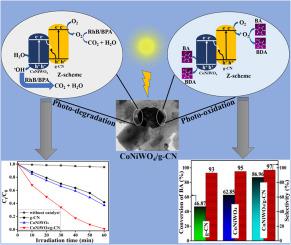Colloids and Surfaces A: Physicochemical and Engineering Aspects ( IF 4.9 ) Pub Date : 2021-09-22 , DOI: 10.1016/j.colsurfa.2021.127606 Umair Alam 1 , Nishith Verma 1, 2

|
Designing a photocatalyst with strong redox ability and broad absorption of visible light is challenging in the field of photocatalysis. In this study, a series of novel Z-scheme-based CoxNi1-xWO4/g-C3N4 (x = 0, 0.2, 0.5, 0.8 and 1) photocatalysts are synthesized with a view to increasing their redox abilities and improve their photocatalytic activities under broad absorption of visible light. The physicochemical properties are investigated, and the data show that an intimate stable heterojunction is formed between the bimetallic tungstate (CoNiWO4) and g-C3N4 (g-CN). Bifunctional properties of the synthesized catalysts are assayed by studying the decomposition of rhodamine B (RhB), bisphenol A (BPA), and selective conversion of benzyl alcohol (BA) to benzaldehyde (BDA). The composite material containing 1:1 molar ratio of Co/Ni shows the highest activity towards the degradation of RhB (99.8%) and BPA (99.32%), and the conversion of BA to BDA (86.96%), each at 1 g/L-dose. The well-matched band structure between CoNiWO4 and g-CN facilitates the formation of a Z-scheme charge transfer path, which prolongs the life time of the photoinduced charge carriers with high redox power, thus enhancing the photocatalytic activity. An intensive study of the mechanism proves that the degradation is driven by the hydroxyl (•OH) and superoxide (•O2-) radicals, indicating that CoNiWO4/g-CN follows the Z-scheme charge transfer pathway. The current study has shown the superior photocatalytic activity among all tungstate-based hybrid photocatalytic materials for the degradation of complex organic pollutants, and selective transformation of BA to BDA. The findings in this study provide a new direction to the development of an efficient direct Z-scheme Co-Ni bimetallic tungstate-based photocatalyst for several redox reactions, especially mineralization of recalcitrant aqueous organic compounds.
中文翻译:

基于直接Z-scheme的新型钨酸镍钴/石墨氮化碳复合材料:增强光催化降解有机污染物和苯甲醇氧化
设计一种具有强氧化还原能力和广泛吸收可见光的光催化剂在光催化领域具有挑战性。本研究合成了一系列新型 Z 型 Co x Ni 1-x WO 4 /gC 3 N 4 (x = 0, 0.2, 0.5, 0.8 and 1) 光催化剂,以提高其氧化还原能力并提高它们在可见光的广泛吸收下的光催化活性。研究了理化性质,数据表明在双金属钨酸盐 (CoNiWO 4 ) 和 gC 3 N 4之间形成了紧密稳定的异质结(g-CN)。通过研究罗丹明 B (RhB)、双酚 A (BPA) 的分解和苯甲醇 (BA) 向苯甲醛 (BDA) 的选择性转化,分析了合成催化剂的双功能特性。含有 1:1 摩尔比 Co/Ni 的复合材料对 RhB (99.8%) 和 BPA (99.32%) 的降解以及 BA 到 BDA (86.96%) 的转化率均表现出最高的活性,每 1 g/ L-剂量。CoNiWO 4和g-CN之间良好匹配的能带结构促进了Z型电荷转移路径的形成,从而延长了具有高氧化还原能力的光生电荷载流子的寿命,从而提高了光催化活性。对该机制的深入研究证明降解是由羟基(•OH) 和超氧化物 ( • O 2 - ) 自由基,表明 CoNiWO 4 /g-CN 遵循 Z 型电荷转移途径。目前的研究表明,在所有基于钨酸盐的杂化光催化材料中,在降解复杂有机污染物和将 BA 选择性转化为 BDA 方面具有优异的光催化活性。本研究的发现为开发用于几种氧化还原反应的高效直接 Z 型 Co-Ni 双金属钨酸盐基光催化剂提供了新的方向,尤其是顽固的水性有机化合物的矿化。











































 京公网安备 11010802027423号
京公网安备 11010802027423号